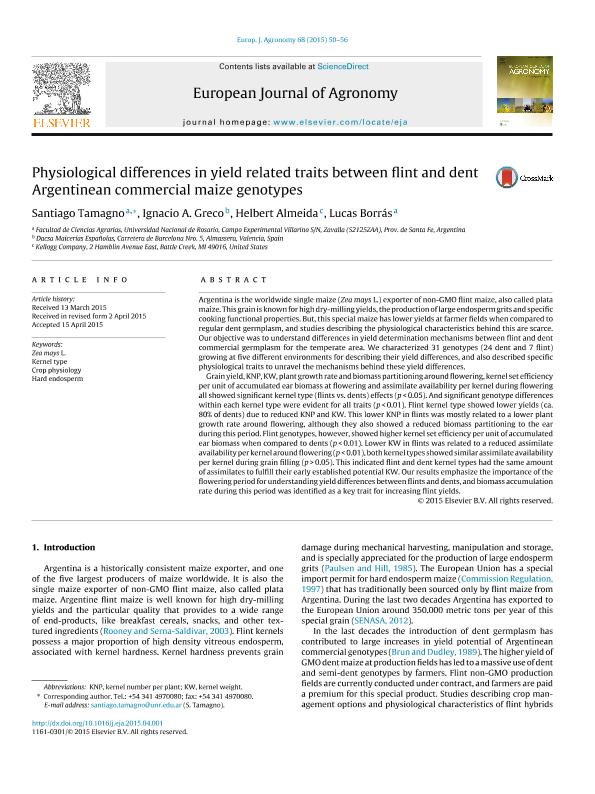Artículo
Physiological differences in yield related traits between flint and dent Argentinean commercial maize genotypes
Fecha de publicación:
08/2015
Editorial:
Elsevier Science
Revista:
European Journal Of Agronomy
ISSN:
1161-0301
Idioma:
Inglés
Tipo de recurso:
Artículo publicado
Clasificación temática:
Resumen
Argentina is the worldwide single maize (Zea mays L.) exporter of non-GMO flint maize, also called plata maize. This grain is known for high dry-milling yields, the production of large endosperm grits and specific cooking functional properties. But, this special maize has lower yields at farmer fields when compared to regular dent germplasm, and studies describing the physiological characteristics behind this are scarce. Our objective was to understand differences in yield determination mechanisms between flint and dent commercial germplasm for the temperate area. We characterized 31 genotypes (24 dent and 7 flint) growing at five different environments for describing their yield differences, and also described specific physiological traits to unravel the mechanisms behind these yield differences.
Grain yield, KNP, KW, plant growth rate and biomass partitioning around flowering, kernel set efficiency per unit of accumulated ear biomass at flowering and assimilate availability per kernel during flowering all showed significant kernel type (flints vs. dents) effects (p < 0.05). And significant genotype differences within each kernel type were evident for all traits (p < 0.01). Flint kernel type showed lower yields (ca. 80% of dents) due to reduced KNP and KW. This lower KNP in flints was mostly related to a lower plant growth rate around flowering, although they also showed a reduced biomass partitioning to the ear during this period. Flint genotypes, however, showed higher kernel set efficiency per unit of accumulated ear biomass when compared to dents (p < 0.01). Lower KW in flints was related to a reduced assimilate availability per kernel around flowering (p < 0.01), both kernel types showed similar assimilate availability per kernel during grain filling (p > 0.05). This indicated flint and dent kernel types had the same amount of assimilates to fulfill their early established potential KW. Our results emphasize the importance of the flowering period for understanding yield differences between flints and dents, and biomass accumulation rate during this period was identified as a key trait for increasing flint yields.
Palabras clave:
Knp
,
Kernel Number Per Plant
,
Kw
,
Kernel Weight
Archivos asociados
Licencia
Identificadores
Colecciones
Articulos(CCT - ROSARIO)
Articulos de CTRO.CIENTIFICO TECNOL.CONICET - ROSARIO
Articulos de CTRO.CIENTIFICO TECNOL.CONICET - ROSARIO
Citación
Tamagno, Santiago; Greco, Ignacio A.; Almeida, Helbert; Borras, Lucas; Physiological differences in yield related traits between flint and dent Argentinean commercial maize genotypes; Elsevier Science; European Journal Of Agronomy; 68; 8-2015; 50-56
Compartir
Altmétricas




